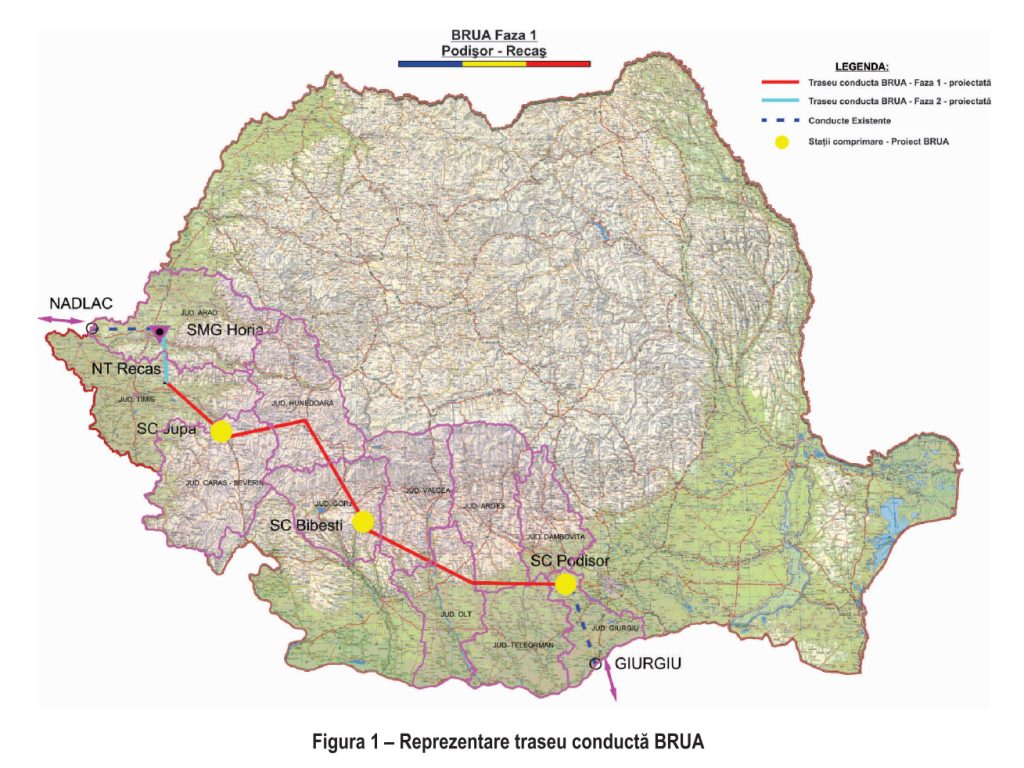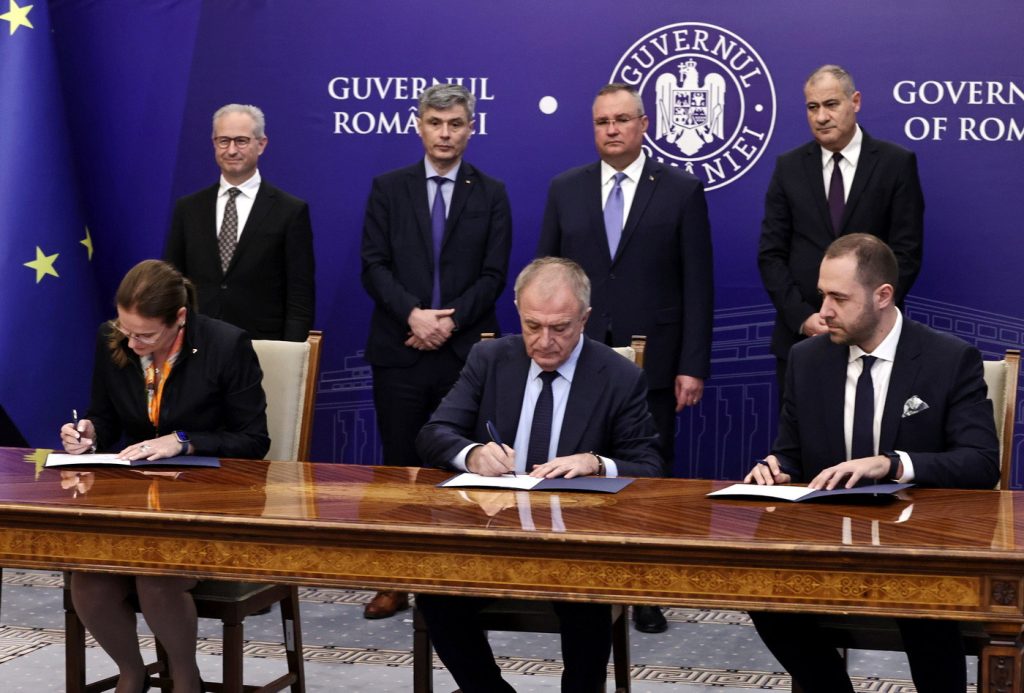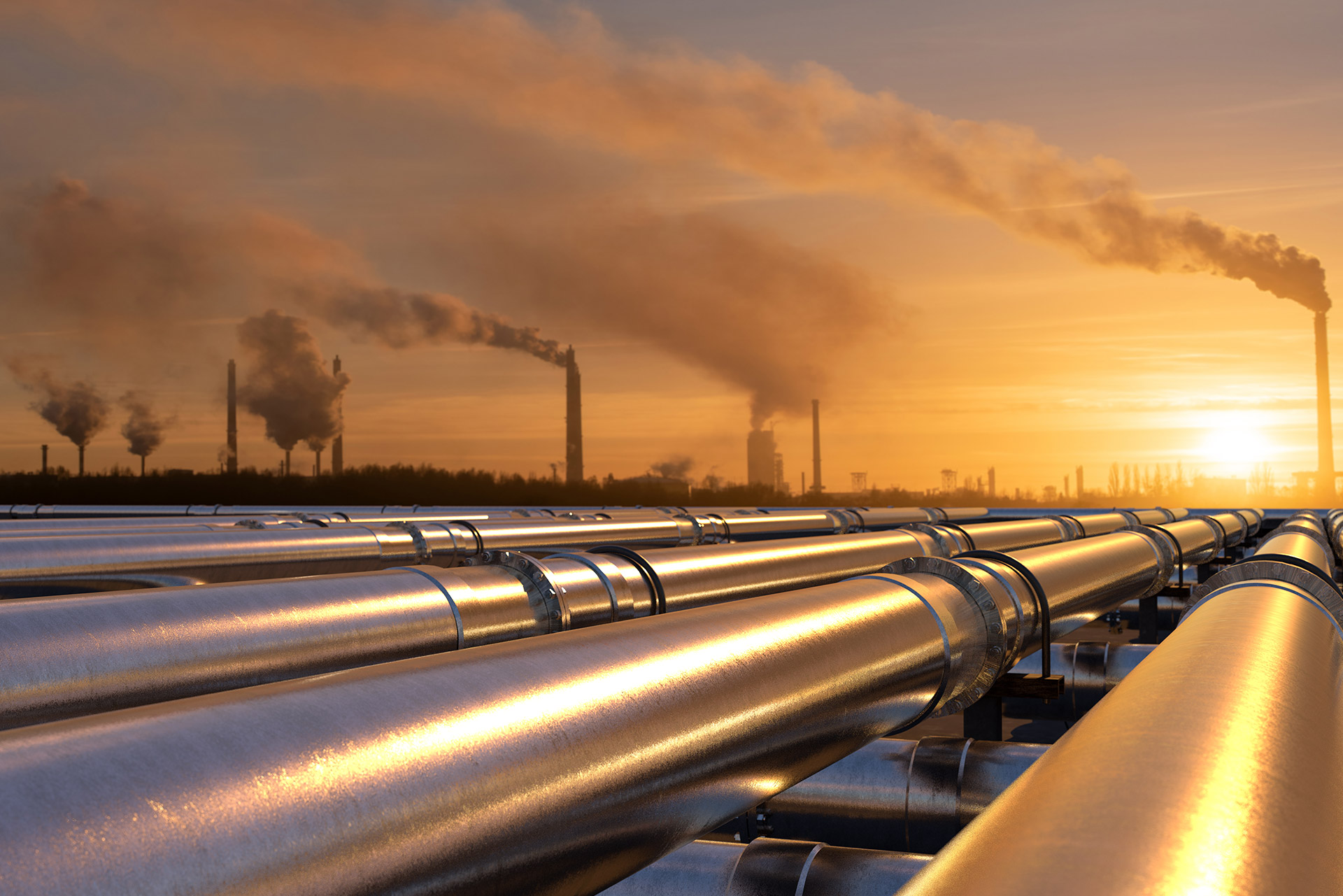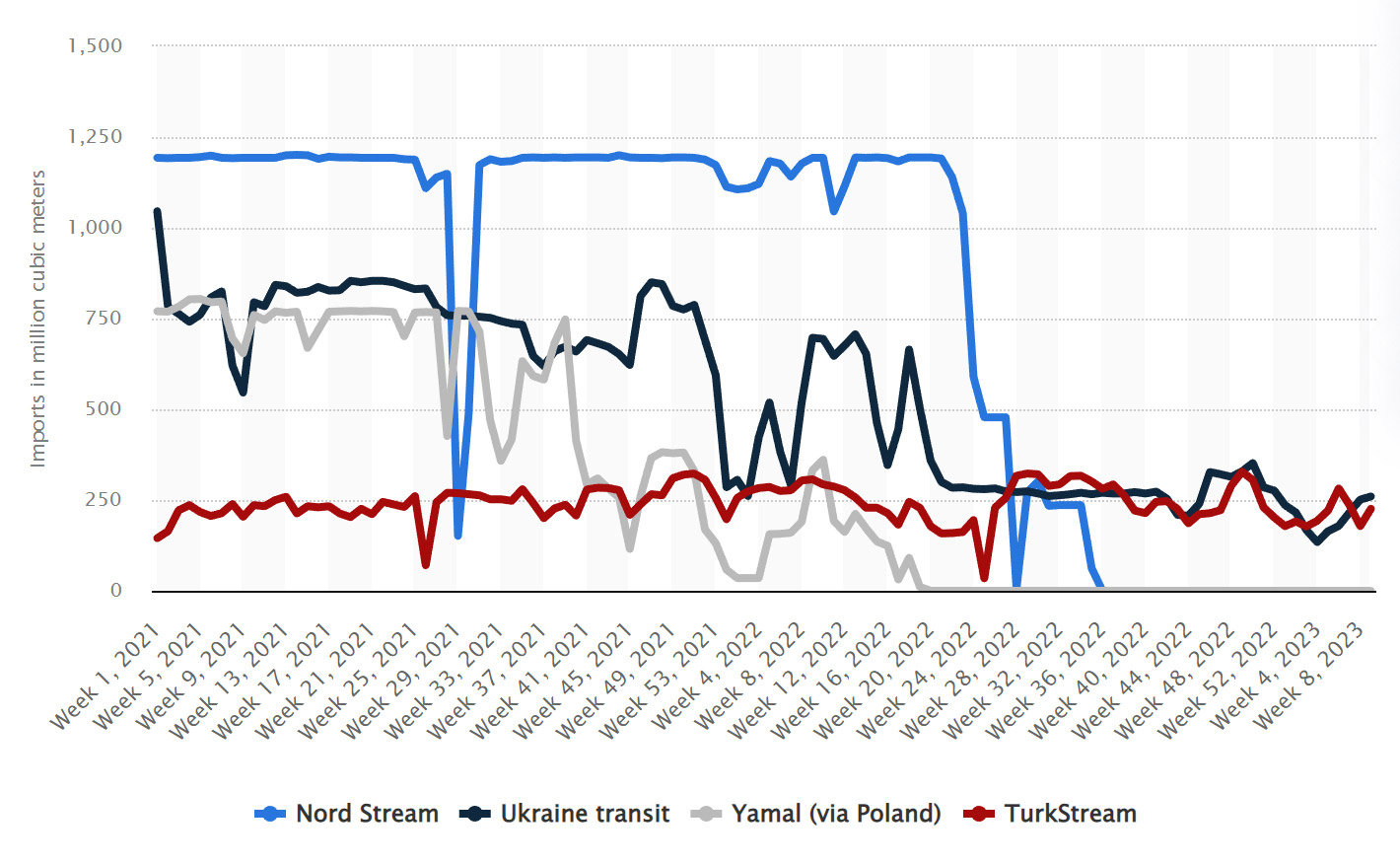In 2022, energy security has become one of the European Union's topics of interest, due to the fact that Russia has almost completely stopped the supply of natural gas to EU countries. In order to ensure a secure and affordable supply, the EU is considering various measures, including increasing its own production, but also diversifying suppliers and supply routes, which will significantly reduce the countries' dependence on Russia. In this situation, Romania can capitalize on a number of its own strengths, including its geographical position, which is conducive to becoming a major energy hub, its existing and developing infrastructure and available resources.
WHY IS NATURAL GAS IMPORTANT FOR EUROPE?
Natural gas consumption in the EU is significant: in 2021, the 27 EU Member States consumed 412 bcm, used in power generation, heating and industrial applications. In terms of residential consumption, we note that in 2021, 30% of the dwellings in the Union were heated with natural gas.
The year 2022 was a year of energy crisis for the European Union, marked by fluctuating prices, with a maximum of 340 euro/MWh in August 2022, followed by a return to 40 euro/MWh in March 2023. Short-term adjustments were mainly based on a strong increase in LNG (liquefied natural gas) imports as well as reduced domestic demand.
At the national level, the plan for moving towards energy independence varies from country to country, depending on the degree of dependence on Russian gas, geographical location, domestic resources, etc. In the case of Central and Eastern European countries, traditionally linked to Russian gas, the stakes are even higher, with a geopolitical component, heightened by the geographical proximity to Russia. For example, Poland, where Gazprom has stopped gas deliveries from April 2022, invested in an LNG terminal and Norwegian gas transportationthrough the Baltic Pipeline across Denmark.
Central and Eastern European countries are integrating the development of renewables, diversification of supply sources by building LNG import capacity, and better integration of regional gas markets into their anti-dependency strategies. These, together with consumption efficiency, are emerging as solutions to the gas crisis.
Current Russian gas imports from the continent, by pipeline routes (source: statista.com)
BRUA. ROMANIAN SUCCESS STORY WITH BENEFITS FOR CENTRAL AND EASTERN EUROPE
BRUA (an acronym of the names of the participating countries Bulgaria, Romania, Hungary and Austria), is a new natural gas transportation corridor "to ensure that the volumes of natural gas from these sources can be exploited on the Romanian and European markets and that permanent physical bi-directional flow on the interconnections with Bulgaria and Hungary is possible" (cf. Transgaz). This corridor allows Romania to connect to regional transport corridors, responding to new opportunities created by the diversification of natural gas transportation routes from the Caspian Sea area to Central Europe. It also facilitates Romania's access to European markets, a useful element in the exploitation of natural gas resources in the Black Sea.
As a reminder, in the Black Sea there are ongoing exploitation projects developed by BSOG, in the Midia perimeter. New exploration is also planned in the Neptun Deep perimeter, developed by Romgaz and OMV Petromtowards which important steps have been taken.
BRUA - part of the Vertical Corridor
BRUA is part of what is called The vertical corridor, an initiative to interconnect gas networks in order to increase the variety of gas sources and to support competition between suppliers. According to MFAThe implementation of the Vertical Corridor will link the natural gas transmission systems of Greece, Bulgaria, Romania, Hungary and Austria in order to take up some of the gas volumes that could be made available through the Southern Corridor infrastructure. The components of the Vertical Corridor are the Greece-Bulgaria Interconnector, the Romania-Bulgaria Interconnector and the BRUA.
The Vertical Corridor was initiated by the signing of a Memorandum of Understanding by the transport operators involved in December 2019. The first participating companies were the system operators from Romania - SNTGN TRANSGAZ, Bulgaria - BULGARTRANSGAZ, Hungary - FGSZ, Greece - DESFA, as well as ICGB - the company operating the Greece-Bulgaria interconnector - IGB, after the relevant ministries of Greece, Bulgaria, Romania and Hungary signed a joint declaration of the Energy Ministers for the natural gas "Vertical Corridor" in 2016 at the CESEC meeting in Budapest.
BRUA - a successful project
In Romania, the development of NTS as part of BRUA is represented by the construction of a new pipeline connecting the Podișor Technological Node with the Horia Gas Metering Station (GMS) in the direction Podișor- Corbu-Hurezani- Hațeg- Recaș- Horia.
The implementation of the BRUA Project on the Romanian territory was conceived to comprise 2 phases:
Phase 1:
- Podișor - Recaș natural gas transmission pipeline (479 km)
- Gas compression stations (SCG) at Podișor, Bibești, Jupa, each station being equipped with two compression aggregates (one in operation and one in reserve), with the possibility of ensuring the bidirectional flow of gas.
Phase 2:
- Recaș - SMG Horia natural gas transmission pipeline (50 km)
- Amplification SCG Podișor, SCG Bibești and SCG Jupa, each station being equipped with an additional compressor;
- Amplify SMG Horia.
By implementing the project "Development on Romanian territory of the National Natural Gas Transportation System on the Bulgaria-Romania-Hungary-Austria corridor, Podișor- SMG Horia and 3 new compressor stations (Jupa, Bibești and Podișor) (Phase 1)" will achieve, according to the initiating company, Transgaz, "the following objectives:
- diversification of natural gas supplies to European countries;
- transportation of Caspian gas reserves to Central European markets;
- Providing 1.5 billion cubic meters/year of natural gas transportation capacity to Bulgaria;
- development of a transportation capacity of 1.75 billion cubic meters/year towards Hungary;
- Romania's gas supply security through access to new gas sources."
BRUA. European trust and funding
BRUA Phase 1 was completed in November 2020, the project realizable value is 423 million euro. STC Jupa was inaugurated on September 30, 2019, STC Podișor was inaugurated on October 31, 2019, and STC Bibești was inaugurated on August 23, 2020: financialintelligence.ro)
Transgaz successfully implemented the BRUA Phase 1 project with a saving of 11% compared to the initially budgeted amount, mainly as a result of concluding contracts through transparent procurement procedures in a competitive environment.
As regards the European contribution, Transgaz points out that at "On September 9, 2016, the grant contract was signed with INEA in the amount of 179,320,400 Euro, representing 40% of the estimated eligible expenditure for the BRUA Phase I project".

Photo source: transgaz.ro
To finance the project "Development of the National Natural Gas Transportation System on the Bulgaria - Romania - Hungary - Austria corridor" (Phase I) SNTGN Transgaz SA has contracted long-term loans in the amount of EUR 200 million on extremely favorable terms from prestigious international financial institutions, the European Investment Bank, the European Bank for Reconstruction and Development and Banca Comercială Română.

THE CONNECTION TO THE BLACK SEA. A new future for offshore gas
Photo source: gov.ro
On March 16, 2023, an agreement between Transgaz, OMV Petrom and Romgaz was signed at the Victoria Palace, in the presence of the Romanian Prime Minister, Nicolae Ciucă. According to the Prime Minister's statement, cited by Agerpres construction of a natural gas transmission pipeline in the direction Tuzla-Podișor with a length of over 300 kilometers. Estimated at 500 million euro, this investment will enable gas from the Black Sea to enter the national transportation system at the Podișor technological node and thus reach economic operators and households in the localities connected to the system".
Info about the Tuzla-Podișor pipeline:
- A total length of approximately 308.3 km which will connect the Black Sea Coast with the Podișor Technological Node in the direction of the Black Sea Coast - Amzacea - Vlașin - Podișor.
- Podișor Gas Compressor Station, the pipeline Țărmul Mării Negre - Podișor is connected to the 800 x 63 bar Dn pipeline Podișor - Corbu, which is part of the natural gas transportation corridor Bulgaria-Romania-Hungary-Austria.
- Transgaz has allocated a transmission capacity of 1,323,920,520 MWh for the period May 1, 2026 - October 1, 2042.
GREECE-BULGARIA INTERCONNECTOR
Another project bringing new sources of natural gas to Romania and Europe is Greece-Bulgaria interconnector. This connector also facilitates access to LNG terminals, for a secure supply to our country and beyond.
"The Greece-Bulgaria Interconnector, part of the Vertical Corridor, will link the Southern Corridor, namely the Trans Adriatic Pipeline and BRUA, through Giurgiu - Ruse, taking gas from the Caspian Sea area, Azerbaijan and the Shah Deniz 2 field, as well as from LNG terminals in northern Greece. The Vertical Corridor will diversify gas sources and give Romania, Bulgaria and other countries in the Balkans and Central and Eastern Europe access to gas sources other than the traditional ones. The first phase of the pipeline will have a capacity of 3 billion cubic meters per year (bcm/year), while the second phase, after the construction of a compressor station at Komotini, will have a capacity of 5 bcm/year. The Greece-Bulgaria Interconnector, by connecting to the Trans-Balkan Corridor, can take natural gas from the Caspian Sea area and Azerbaijan, providing additional security of gas supply for Romania and the entire region.", said Ion Sterian, describing the role and importance of this project.
STRENGTHENING COOPERATION WITH GREECE AND OPENING THE VERTICAL CORRIDOR TO NON-EU COUNTRIES
On December 1, 2022, in Athens, the parties involved in the Vertical Corridor, including Transgaz, signed a new Memorandum of Understanding on the Vertical Corridorwhich, as a signatory party, includes Greece's Gastrade, the owner, developer and future operator of the offshore LNG (liquefied natural gas) terminal in northern Greece at Alexandroupolis.
In the new MOU it is foreseen that the parties may consider the involvement of non-EU states if this approach is relevant for the implementation of the Vertical Corridor concerned.
COOPERATION WITH AZERBAIJAN. THE ROAD TO SUFFICIENT SUPPLIES STARTS AT THE CASPIAN SEA
In its search for new natural gas suppliers, the European Union has struck deals with countries outside the continent, such as Egypt, Israel and Azerbaijan.
Deal with Azerbaijan will increase European consumers' access to more natural gas through pipelines Southern Gas Corridor. Agreement signed on July 18, 2022 between the EU and the Caspian Sea state doubles the amount of gas transported through the Southern Corridor, up to 20 million cubic meters annually.
Romania and Azerbaijan have a Strategic partnershipestablished in 2009, with energy, economic and security cooperation, etc. In fact, our country was the first EU member to establish a strategic partnership with Azerbaijan.
For natural gas, operators in Bulgaria, Romania, Hungary and Slovakia have proposed, on October 1, 2022, a natural gas transportation initiative through integrated gas transportation networks. Bulgartransgaz, Transgaz, Transgaz, FGSZ and Eustream have outlined joint actions on expanding cooperation between the European Union and Azerbaijan by transporting additional quantities of natural gas through their existing networks.
Based on the cooperation between the companies over the years, and with the support of EU funds, the 4 operators expressed their confidence that such a project would provide a secure alternative route for gas supplies in sufficiently large volumes. With an infrastructure requiring minimal, time-saving interventions, could transport up to 5 billion cubic meters of natural gas a year, from Turkey and Greece to Eastern, Central and Western Europe via Bulgaria, Romania, Hungary and Slovakia.
CONNECTION WITH THE REPUBLIC OF MOLDOVA. ALTERNATIVE NEEDED BY CITIZENS FROM ACROSS THE PRUT
Transgaz has completed the Iasi-Ungheni-Chisinau interconnection pipeline, which proved particularly useful in the context of the energy crisis. Thus, in December 2022, the Russian company Gazprom limited and then stopped the supply of natural gas to Moldova. It should also be noted that Moldova has no storage capacity of its own, according to IEA, using facilities in Romania (equivalent quantities needed for approx. 1 week) and Ukraine.
In this situation, our country delivered gas to the Republic of Moldova, as reported by RFI. Thus, Romania has been able to help Moldova's energy stabilization and maintain economic and even social balance in an area very close to the conflict zones in Ukraine.






